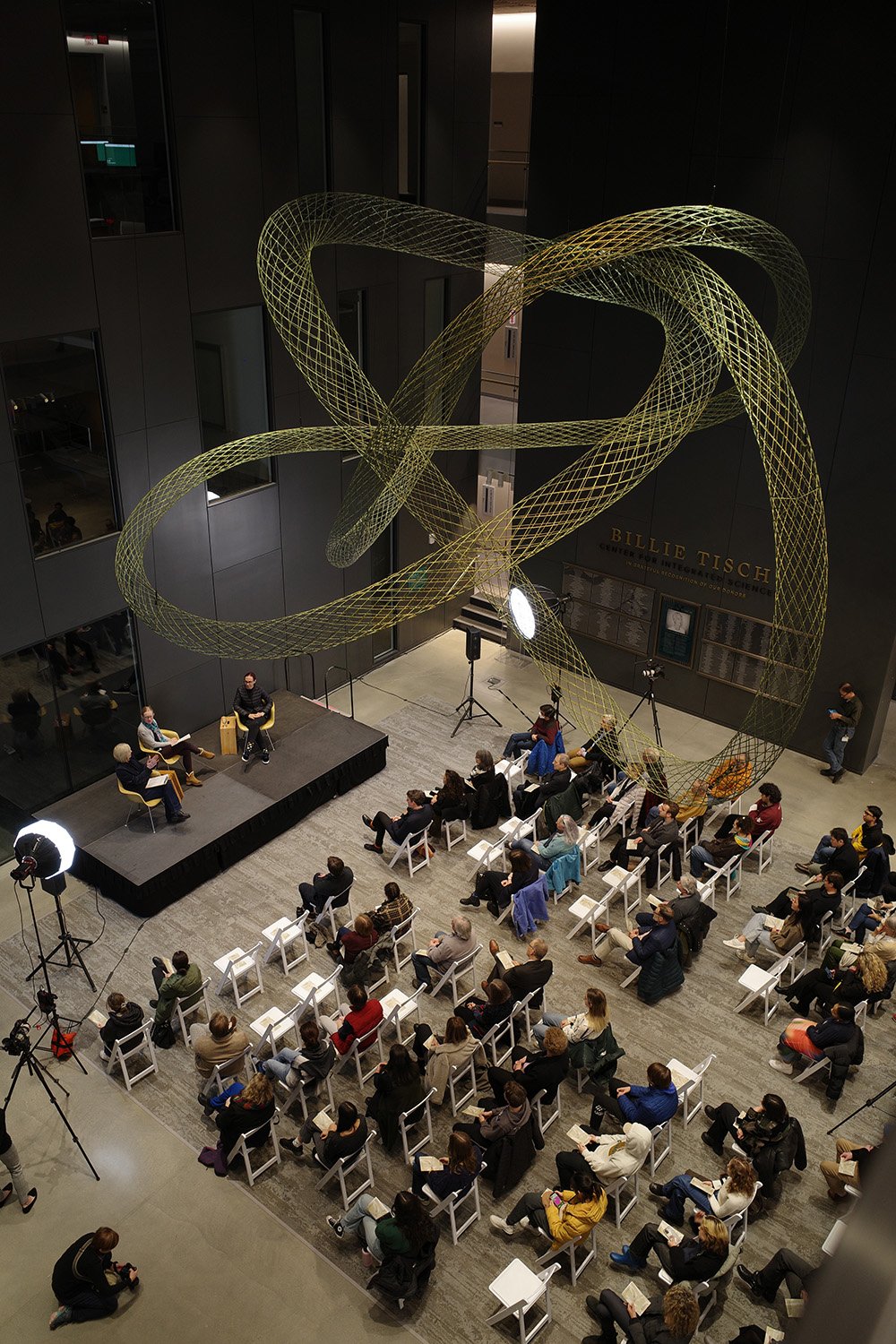






ENTANGLEMENT, 2022
Billie Tisch Center for Integrated Sciences, Skidmore College
Stainless steel, paint.
206 x 270 x 206”
all photos: Nicholas Knight
Press Release
Alyson Shotz Creates New Sculpture for Skidmore College
‘Entanglement’ soars above the atrium of the new Billie Tisch Center for Integrated Science
SARATOGA SPRINGS, NY (October 25, 2022) — Skidmore College is excited to announce the installation of the first permanent work of art for a college building, Entanglement, a monumental site-specific sculpture by acclaimed artist Alyson Shotz in the new Billie Tisch Center for Integrated Sciences.
To mark the occasion, Shotz will speak about her work with two Skidmore College faculty members on Thursday, November 17, at 6 pm. Mary Crone Odekon, Department Chair and Professor of Physics and Kenan Chair of Liberal Arts, and Rachel Roe-Dale, program director First Year Experience and Professor of Mathematics, were both members of the committee that commissioned Shotz. The three will speak beneath Shotz’s new sculpture.
Entanglement soars above the BTCIS Atrium. The 750-pound sculpture turns and twists impossibly in midair, like a giant open knot or a mobius strip that leads the eye in endless movement around its sinewy curves. As a viewer moves beneath the sculpture, its painted steel shimmers and its colors transform from gold to green to blue.
“I’m very excited to have this new work in the Center for Integrated Sciences,” Shotz said recently during a break in the installation of the work. “It’s the perfect place for this sculpture.”
“Alyson Shotz’s Entanglement embodies the Skidmore educational values of creativity and interdisciplinarity. It’s a magnificent rendering of creative and analytical thought brought together into a powerful and thought-provoking display of motion and feeling,” President Marc C. Conner said. “I am grateful to Alyson for her extraordinary work. It’s wonderful to know that for years to come, our campus community and visitors will get to be in the presence of this sculpture and all the reflection and emotion it suggests.”
Shotz is an interdisciplinary artist known for breaking down boundaries between media, working across sculpture, photography and video. Entanglement also crosses disciplines, she says, with resonances in the physical sciences, art, and culture.
“Entangled structures are fundamental to DNA proteins, turbulent plasmas, fluid dynamics, and the quantum-mechanical foundations of nature itself,” Shotz said. “They are written into the basic design of biological and physical systems, and represent one of the earliest human technological advances. This interplay of natural form and human ingenuity provides a huge inspiration. I have also been drawn to the deep history of knots in art and culture: the endless knot is a Buddhist symbol representing the interconnectedness of all things and the intertwining of emptiness and form. Knot patterns can also be found in Roman, Byzantine, Chinese, and Islamic art and architecture, as well as in Celtic iconography.”
Shotz was selected to create a new work of art for BTCIS by a committee of faculty and administrators along with Tang Teaching Museum Director Ian Berry. The commission is a return for the artist almost twenty years after her 2003 Tang Teaching Museum exhibition Opener 5: Alyson Shotz — A Slight Magnification of Altered Things, which presented her sculpture, video, photography, and painting – an interdisciplinary survey that explored art and science connections.
The November 17 event with Shotz, Odekon, and Roe-Dale is part of the Tang Teaching Museum’s series of Dunkerley Dialogues, which pair Skidmore professors with artists in a conversation format, which is often a catalyst for new connections and understandings across disciplines, and can spark new ideas for all participants. Dunkerley Dialogues are made possible by a generous gift from Michele Dunkerley ’80.
Shotz saw multiple benefits in using this new process. It allowed her to design an open structure with precision curves that could be made much quicker and for less money than traditional welded steel processes. It was a zero-waste process that required almost no packing materials. It also let her expand her artistic practice, allowing her to create new structures that were impossible to make before this technology existed, while at the same time making connections with previous work.
“Entanglement explores the idea that a shape can be defined by space rather than mass. There is much more space in this sculpture than steel. It also asks, How does perception define the experience of space? If you look at this sculpture from only one point of view, it might be difficult to understand, you have to move around it to experience it fully. As your point of view changes and the light changes, the shape itself changes. These concerns flow through all of my work.”